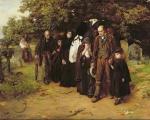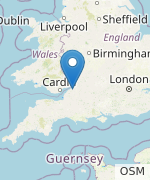The Victorian Way of Death
Dr Helen Frisby
- Region:
- Anywhere
- Notice Period:
- Short (maybe less than one month's notice)
- Type:
- Academic, Hobby, Rotary
- Fee:
- Paid: £50.00 plus travel/subsistence as agreed
- Category:
- History
- Updated:
- 15th August 2025
- Tagged:
- History | History Of Art | Victorian Funerals | Death And Dying
Frank Holl’s 1872 painting I am the Resurrection and Life (Village Funeral) is an excellent example of social realism: an artistic movement which aimed to draw attention to working-class living conditions. In this painting Holl captures a moment in time and grief, as a careworn funeral cortège wends its weary way through a rural churchyard. While his subjects have clearly attempted to assemble the trappings of a respectable funeral, their efforts are obviously, painfully threadbare; a stark reminder that all were (and still are) by no means equal in death.
In this talk historian Dr Helen Frisby will explore the story behind this moment; where would these people have come from, and where were they going? What customs and rituals would have helped or maybe hindered them along the way - and what lessons might all of this have about grief and loss for us today?
Views: 261 | Enquiries: 0About Dr Helen Frisby
Based on two decades of research, my scholarly yet sympathetic talks about funeral customs past, present and future will get your group thinking and talking about how exactly do we deal with this inevitable fact of life.
We're all mortal: and the ways in which we approach, avoid and confront this fact through funeral customs can tell us a lot about human nature. I'm fascinated by how people use ritual so creatively to work though our relationships with the dead, and how funerary rituals change - or sometimes don't - throughout history.
I'm an internationally recognised expert on the history and folklore of death, dying and funerals. My publications include the Shire Library book 'Traditions of Death and Burial' (Bloomsbury, 2019) as well as various academic articles. Previously I've appeared on the History Channel discussing Victorian funerals with Johnny Vaughan, and on BBC radio talking about sin-eating and other historic funeral customs. I love working with all sorts of groups large and small, so do please get in touch to discuss your requirements.
Other Talks on SpeakerNet by Dr Helen Frisby
Send a message to the speaker
If you are interested in this talk and wish to contact the speaker, please complete the following form:


